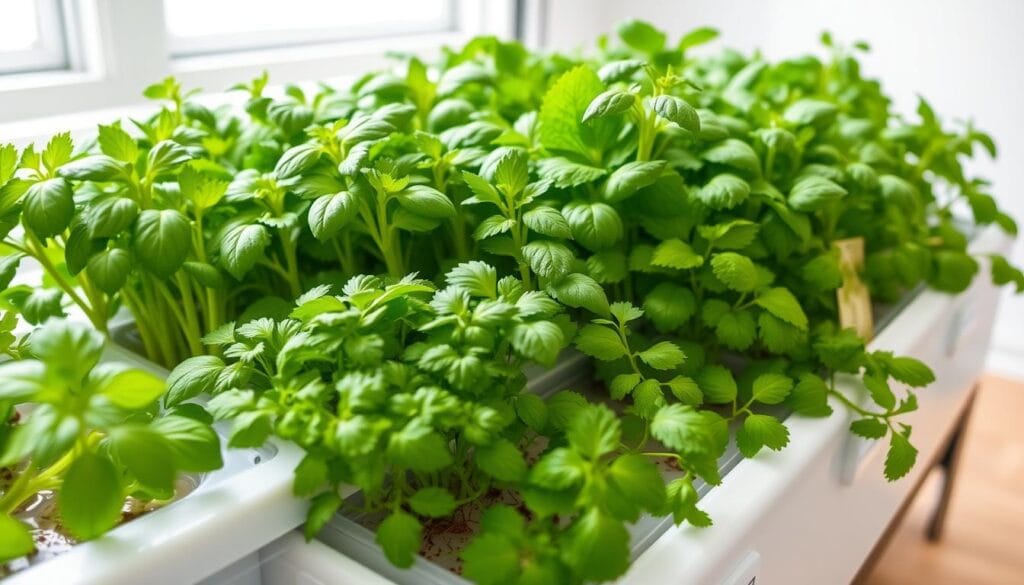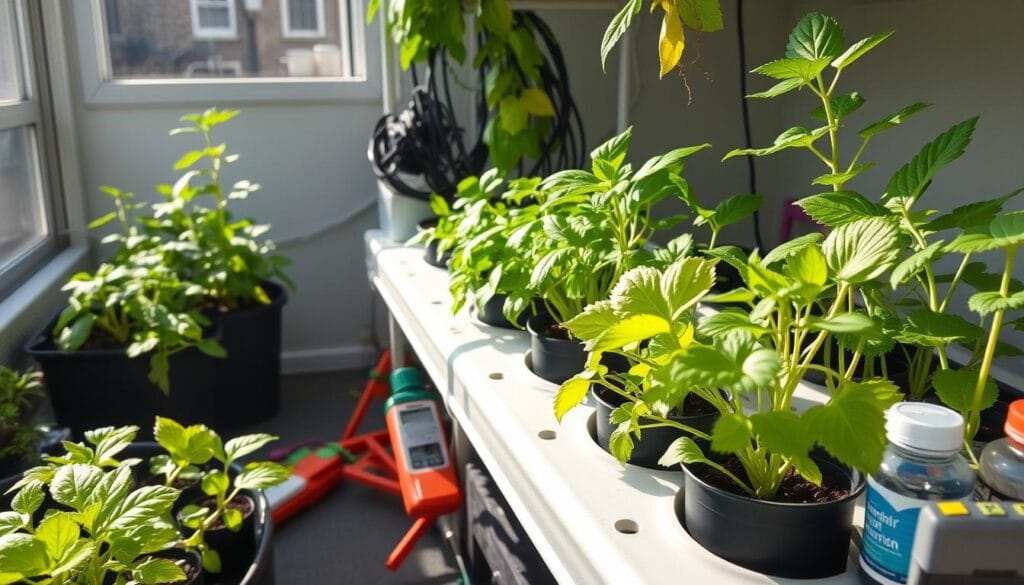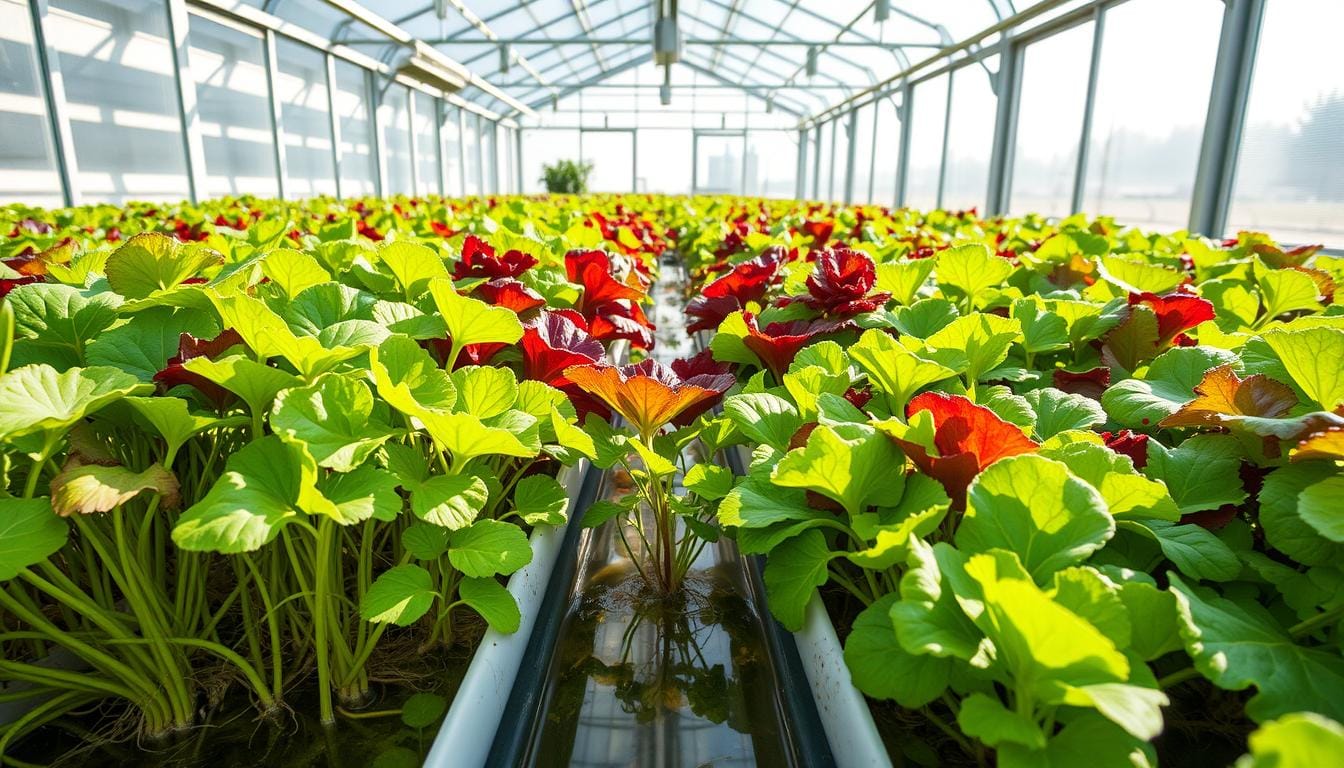Fast Hydroponic Growth Plants are revolutionizing urban farming and indoor gardening. Growing plants without soil at home is not only exciting but also highly efficient.
Key Takeaways
- Hydroponic gardening lets you grow veggies and herbs all year in small spaces.
- It uses water with nutrients instead of soil, making plants grow faster and stronger.
- Hydroponic systems include LED grow lights and need regular checks for plant health.
- This method works for most plants, except those needing a lot of space or deep roots.
- Leafy greens, herbs, and microgreens do well in hydroponics, offering quick harvests and lots of yield.
Understanding Hydroponic Growing Basics
Hydroponics is a modern technique that allows plants to grow without soil, using a nutrient-rich water solution instead. It sends nutrients straight to the roots. This method cuts down water use by up to 90% and lets you grow many crops in small spaces.
Benefits of Soil-less Growing
Hydroponics has many benefits over traditional gardening. It makes plants grow faster and yields more in less space. It also gets rid of weeding and pest problems. Plus, you can grow plants all year, giving you fresh food anytime.
Essential Equipment and Setup
To start with hydroponics, you need some basic tools. These include grow lights, a water tank, and a way to get nutrients to the plants. There are three main systems for beginners: wick, water culture, and ebb and flow. Each needs a specific setup, but they all need the right pH and light.
Nutrient Solutions and Water Management
Managing nutrients is key to a successful hydroponic garden. Plants need different nutrients, so you must adjust the solution. Testing and adjusting the water regularly is important to keep the pH right and ensure your plants get what they need.
Fast Hydroponic Growth Plants: The Best Options for Beginners to Grow Efficiently
Leafy greens and herbs are great for beginners in hydroponics. They grow well without soil and give lots of food quickly. You can get up to 2.7 million servings of greens from just 1.5 acres of land.
Microgreens grow the fastest, ready in 1-3 weeks. They are packed with nutrients and quick to harvest. Leafy greens like lettuce and kale take 25-60 days to grow, perfect for new gardeners.
Green onions and celery are good for beginners too. Green onions need a pH of 6.2 to 6.8 and 8-10 hours of light. Celery needs careful pH and nutrient management for best growth.
Herbs like basil and parsley grow faster in hydroponics than in soil. They taste and smell stronger, great for cooking.
| Plant Type | Estimated Harvest Time | Optimal Growing Conditions |
|---|---|---|
| Microgreens | 1-3 weeks | Varied light requirements, cool temperatures |
| Leafy Greens (Lettuce, Kale, Swiss Chard) | 25-60 days | Cooler temperatures, 10-14 hours of light |
| Herbs (Basil, Parsley, Cilantro) | 25-50% faster than soil | Varied light and temperature needs |
| Green Onions | 30-45 days | pH 6.2-6.8, 20-25°C, 8-10 hours of light |
| Celery | 50-80 days | Careful pH and nutrient monitoring |
Start with these easy-to-grow plants to quickly enjoy hydroponics. With the right setup and care, you’ll have a lot of food soon.
Leafy Greens: The Quick-Harvest Champions
Leafy greens are the stars of the hydroponic garden. They grow well without soil, offering a quick harvest. Hydroponic lettuce, spinach, and Swiss chard are favorites for their taste and health benefits.
Lettuce Varieties for Hydroponics
Butterhead, romaine, and oak leaf lettuce are great for hydroponics. They grow fast, ready in 3-4 weeks. Their small size and shallow roots fit well in compact systems.
Spinach and Swiss Chard Growth Patterns
Spinach and Swiss chard love cooler weather, below 75°F. They can handle a light frost, making them good for all year. These greens are packed with vitamins and minerals, boosting your garden’s nutrition.
Optimal Growing Conditions for Leafy Greens
Leafy greens grow well in many hydroponic systems. They need good air, light, and nutrients. Keeping the right pH and nutrients ensures they grow best.
Leafy greens are the hidden gems of hydroponics. They grow fast, are compact, and full of nutrients. Whether it’s lettuce, spinach, or Swiss chard, they’ll please your taste buds and your gardening skills.
Herbs That Thrive in Hydroponic Systems
Herbs love growing in hydroponic systems, where they don’t need soil. Plants like basil and cilantro add amazing flavors to food. These systems make it easy for herbs to grow well with little work.
Basil is a top pick for hydroponic gardens. It does best in a pH of 5.5-6.5 and some light. It’s ready to harvest in 40-60 days. Parsley is also popular for its deep flavor and quick growth in hydroponics.
Cilantro shines in hydroponics, offering a unique taste and lots of nutrients. It grows fast, perfect for new gardeners. Mint is known for its refreshing scent and grows well without much care.
| Herb | Ideal pH Level | Harvest Time | Nutrient Benefits |
|---|---|---|---|
| Basil | 5.5-6.5 | 40-60 days | Vitamin K, Antioxidants |
| Parsley | 6.0-7.0 | 45-60 days | Vitamins A, C, K, Iron, Calcium |
| Cilantro | 6.0-7.0 | 30-45 days | Dietary Fiber, Vitamins A, C, K, Iron, Calcium |
| Mint | 6.0-7.5 | 40-60 days | Vitamin A, Antioxidants |
Hydroponic herbs are great for indoor gardens because they grow small and taste amazing. With the right care, you can have a constant supply of these plants all year.

“Hydroponic systems reduce the need for water by up to 98% compared to traditional soil-based cultivation methods.”
Microgreens: From Seed to Harvest in Days
Hydroponic microgreens are amazing. They grow fast, from seed to harvest in 1-3 weeks. They are perfect for quick, abundant harvests. These tiny greens are full of flavor and vitamins, making them a favorite in kitchens today.
Best Microgreen Varieties
Some top microgreens include broccoli, radish, arugula, and pea shoots. They add color, texture, and lots of nutrients. Although small in size, they are highly nutritious.
Harvesting and Storage Tips
To harvest, wait until they’re 1-3 inches tall. Then, cut them off at the base with clean scissors. Keep them in airtight containers and store them in the fridge. They stay fresh and delicious for as long as a week.
Nutritional Benefits
Microgreens are not just fast-growing; they’re also super nutritious. They have up to 40 times more nutrients than full-grown plants. They’re full of antioxidants, vitamins, minerals, and more. They’re a true superfood that can make any dish better.
“Microgreens are the future of food – they pack a nutritional punch in a tiny package, and they can be grown right in your own home or kitchen.”
Essential Light Requirements and Growing Conditions
Lighting is key for your hydroponic plants to do well. Most leafy greens and herbs need 14-16 hours of light each day. LED grow lights are a good choice because they use less energy and can be adjusted for your plants.
Keeping the right growing conditions is also important. This means keeping the temperature between 60-75°F and making sure there’s enough air movement. This helps prevent mold and helps your plants grow strong.
The lighting needs change based on the plants you’re growing. For example, leafy greens like lettuce, spinach, and kale need light that’s 150 to 250 μmol/m²/s. But, plants that produce fruit, like tomatoes and peppers, need even more light, around 600 to 800 μmol/m²/s.
To make sure your plants get the right hydroponic lighting, use timers for a steady light schedule. Also, adjust the light’s distance, pick the right light spectrum, and keep the lights clean. These steps establish the ideal environment for growth.
| Plant Type | Light Duration | Light Intensity (PPFD) |
|---|---|---|
| Leafy Greens | 10-14 hours | 150-250 μmol/m²/s |
| Fruiting Plants | 14-18 hours | 600-800 μmol/m²/s |
| Herbs | 10-14 hours | 150-250 μmol/m²/s |
By using the right grow lights and optimal growing conditions, you can make a great space for your hydroponic plants. This lets them grow to their best.
Nutrient Management for Optimal Growth
Keeping a balance of nutrients is key for healthy hydroponic plants. To make your garden thrive, knowing about pH levels, nutrient deficiencies, and solution maintenance is crucial.
pH Levels and Monitoring
The best pH range for most plants is 5.5 to 6.5. It’s important to check your solution’s pH often. Use a pH meter to test and adjust with pH up or down as needed.
Common Nutrient Deficiencies
Hydroponic plants can face nutrient shortages, often in nitrogen, phosphorus, and potassium. Signs include yellow leaves, slow growth, and color changes. Watch your plants closely and fix any nutrient issues quickly.
Solution Maintenance Schedule
Change your nutrient solution weekly to keep it fresh. Also, replace it fully every 2-3 weeks for a balanced nutrient supply. This attention will ensure your plants thrive.
“Properly managing the nutrient solution is the key to unlocking the full potential of your hydroponic garden.”
By following these nutrient management tips, you’ll grow a vibrant and productive hydroponic garden.
Common Growing Challenges and Solutions
Starting a hydroponic garden comes with its own set of challenges. But, with the right knowledge and steps, you can beat them. Here are some common issues and how to solve them to keep your plants healthy.
Algae Growth
Algae can quickly spread in your hydroponic system, blocking pumps and stealing nutrients from your plants. To stop this, reduce light on the nutrient solution by covering the reservoir and using dark tubing. Regular cleaning and upkeep of your system also helps fight algae.
Root Rot
Keeping the water oxygen-rich is key to avoiding root rot. Make sure your system has enough air. You can use air stones or water pumps to keep the roots well-oxygenated.
Pest Management
Hydroponic systems attract pests like aphids and spider mites. Fight these with natural enemies, such as ladybugs or lacewings. Or, use organic pest control like neem oil or insecticidal soap. Keep a close eye on your plants and act fast to control pests.
Nutrient Imbalances
It’s vital to have the right mix of nutrients in your hydroponic system for healthy plants. Check the pH levels and adjust the nutrients as needed. Know the common nutrient shortages and fix them early to keep your plants healthy.
By being alert, fixing problems quickly, and taking preventive steps, you can conquer hydroponic gardening challenges. Remember, keeping your system clean and watching your plants closely is crucial for a successful hydroponic garden.

Harvesting Techniques and Timeline
Learning how to harvest hydroponic crops is key to getting the most from your plants. The way you harvest depends on the type of plant. However, the fundamental steps remain the same for everyone.
For leafy greens and herbs, just snip off the outer leaves. This lets the plant keep growing and producing more leaves. Microgreens are cut just above the growing medium for a clean harvest.
- Most hydroponic plants are ready for their first harvest in 3-5 weeks. This varies based on the type of plant and the growing conditions.
- For a steady supply, use a continuous harvesting system. This means regularly taking off mature leaves or stems while the plant keeps growing.
- Always clean and sanitize your harvesting tools. This prevents contamination and keeps your produce safe and healthy.
By learning to harvest hydroponic crops well, you’ll get a lot of fresh, tasty produce all year. Hydroponics lets you control and improve your growing process. Reap the fruits of your efforts.
“Hydroponic systems can accelerate plant growth, making them grow up to five times faster than those cultivated in soil.”
Hydroponics is great for growing plants fast and efficiently. It uses advanced growing methods and careful nutrient management. This leads to much faster growth compared to growing in soil.
Conclusion
Hydroponic gardening offers many benefits, making it ideal for indoor gardening and farming. It uses up to 90% less water compared to conventional farming, demonstrating its high water efficiency.”
This version smooths the transition between sentences and clarifies the meaning a bit more.
The controlled environment lets growers grow plants all year. This means no worries about seasons or bad weather.
Hydroponic systems can grow more plants in less space. This is perfect for cities, dry areas, and harsh climates. They also need less pesticides and manage nutrients well. This makes hydroponic farming sustainable and good for the environment.
Whether you grow a little or a lot, hydroponics are a smart choice. They offer a way to grow food all year. This helps the planet and supports sustainable farming.

